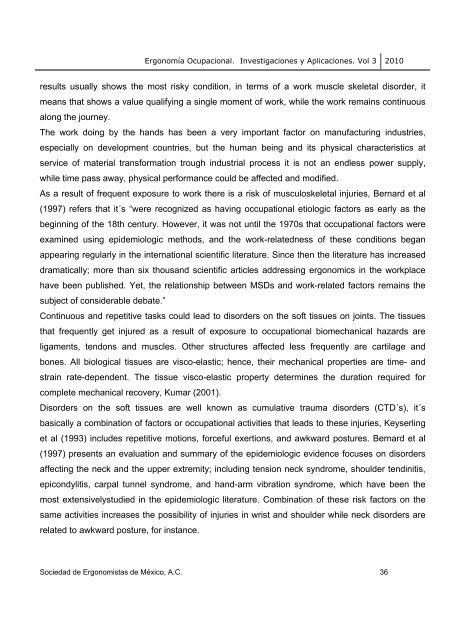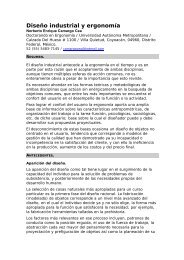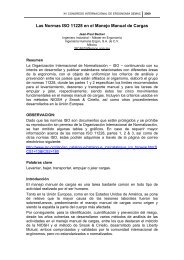ERGONOMÍA OCUPACIONAL - SOCIEDAD DE ERGONOMISTAS ...
ERGONOMÍA OCUPACIONAL - SOCIEDAD DE ERGONOMISTAS ...
ERGONOMÍA OCUPACIONAL - SOCIEDAD DE ERGONOMISTAS ...
Create successful ePaper yourself
Turn your PDF publications into a flip-book with our unique Google optimized e-Paper software.
Ergonomía Ocupacional. Investigaciones y Aplicaciones. Vol 3 2010<br />
results usually shows the most risky condition, in terms of a work muscle skeletal disorder, it<br />
means that shows a value qualifying a single moment of work, while the work remains continuous<br />
along the journey.<br />
The work doing by the hands has been a very important factor on manufacturing industries,<br />
especially on development countries, but the human being and its physical characteristics at<br />
service of material transformation trough industrial process it is not an endless power supply,<br />
while time pass away, physical performance could be affected and modified.<br />
As a result of frequent exposure to work there is a risk of musculoskeletal injuries, Bernard et al<br />
(1997) refers that it´s “were recognized as having occupational etiologic factors as early as the<br />
beginning of the 18th century. However, it was not until the 1970s that occupational factors were<br />
examined using epidemiologic methods, and the work-relatedness of these conditions began<br />
appearing regularly in the international scientific literature. Since then the literature has increased<br />
dramatically; more than six thousand scientific articles addressing ergonomics in the workplace<br />
have been published. Yet, the relationship between MSDs and work-related factors remains the<br />
subject of considerable debate.”<br />
Continuous and repetitive tasks could lead to disorders on the soft tissues on joints. The tissues<br />
that frequently get injured as a result of exposure to occupational biomechanical hazards are<br />
ligaments, tendons and muscles. Other structures affected less frequently are cartilage and<br />
bones. All biological tissues are visco-elastic; hence, their mechanical properties are time- and<br />
strain rate-dependent. The tissue visco-elastic property determines the duration required for<br />
complete mechanical recovery, Kumar (2001).<br />
Disorders on the soft tissues are well known as cumulative trauma disorders (CTD´s), it´s<br />
basically a combination of factors or occupational activities that leads to these injuries, Keyserling<br />
et al (1993) includes repetitive motions, forceful exertions, and awkward postures. Bernard et al<br />
(1997) presents an evaluation and summary of the epidemiologic evidence focuses on disorders<br />
affecting the neck and the upper extremity; including tension neck syndrome, shoulder tendinitis,<br />
epicondylitis, carpal tunnel syndrome, and hand-arm vibration syndrome, which have been the<br />
most extensivelystudied in the epidemiologic literature. Combination of these risk factors on the<br />
same activities increases the possibility of injuries in wrist and shoulder while neck disorders are<br />
related to awkward posture, for instance.<br />
Sociedad de Ergonomistas de México, A.C. 36




